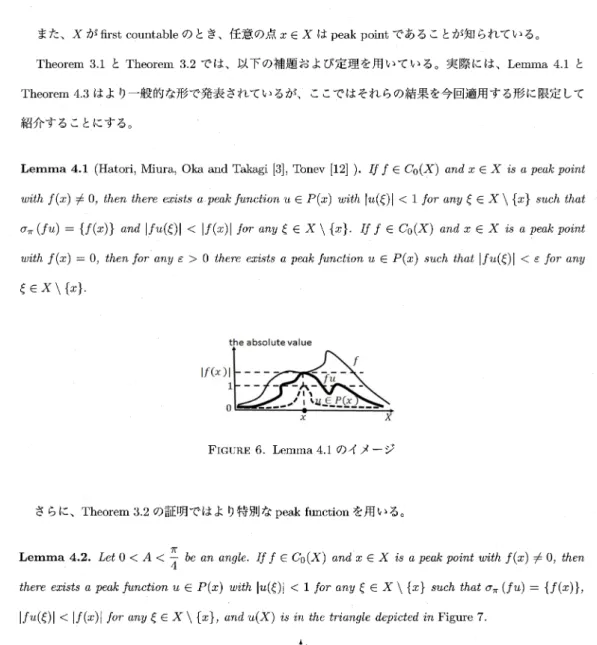積と値域に関する情報をもつ $C_{0}(X)$, $C_{0}(Y)$ 間の写像について (等距離写像研究の多角的アプローチ)
14
0
0
全文
(2) 22. ここで、Theorem 1.1では仮定に線形性が含まれていないことに着目してもらいたい。これより以前に. 扱われていた. preserver. problem の多くは線形性を前提条件として議論されていた。しかし、この結果では. 線形性や乗法性を仮定せず、「積のスペクトル (この場合は関数の値域と一致する) を保存する全射」 とい う仮定のみからその写像の構造を決定している。更に、得られた写像の構造から積のスペクトルを保存す. る写像は乗法的でかつ線形な荷重合成作用素であることがわかる。この結果は多くの研究者によって一般 化され、さまざまな結果が発表されている。そのいくつかを抜粋して紹介する。. なお、本稿では以下の記号と定義を用いることとする。. Definition 1.. (1) C(X) :. (2). A. the space of all. complex function f. es C_{0}(X) :. on a. locally compact. to every $\epsilon$>0 there exists. the space of all. space X that vanish at. (3) f\in C_{0}(X). continuous functions. complex‐valued. a. on a. compact Hausdorff. Hausdorff space X vanishes at. |f(x)|. compact set K\subset X such that. complex‐valued. continuous functions. on a. space X. infinity < $\epsilon$ for all. locally compact. x. Hausdorff. infinity. ,. \displaystyle \Vert f\Vert^{\mathrm{d} =^{\mathrm{e}\mathrm{f} \sup_{x\in X}|f(x)| $\sigma$_{$\pi$}(f)^{\mathrm{d} =^{\mathrm{e}\mathrm{f} { f(x_{0}). :. x_{0}\in X such that. |f(x_{0})|= \Vert f\Vert }. ) -|. -|. f|. FIGURE 1.. (4). A:. a. uniform. algebra. on. X. $\sigma$_{ $\pi$}(f) \Vert f\Vert のイメージ ,. \Leftrightarow^{\mathrm{d}\mathrm{e}\mathrm{f}. (a). A is. (b). A contains the constant functions. (c). for every x_{1},. a. closed. subalgebra. of. C(X). x_{2}\in X, x_{1}\neq x_{2} there ,. exists. an. f\in A. such that. not in K. f(x_{1})\neq f(x_{2}).
(3) 23. (5). A:. a. function. algebra. on. X\Leftrightar ow^{\mathrm{d}\mathrm{e}\mathrm{f}. (a). A is. (b). for every x_{1}, x_{2}. (Rm. Theorem 1.2. closed. a. subalgebra \in X,. of. C_{\mathrm{O} (X). \neq x_{2}. x_{1}. Roy [11]). Let A be. and. there exists. ,. and. a. signum function. Theorem 1.3 ary. of A. If. for. all. f, g. $\alpha$ :. If. T. A\rightarrow A is. :. a. Tonev. A, B. Let. \cdot. be. a. and. uniform algebras. A.. \in. surjection with the property that. homeomorphism $\phi$. T(f)(x)= $\alpha$(x)f( $\phi$(x)) for. such that. [7]).. $\sigma$(f) \mathrm{d}\mathrm{e}\mathrm{f}= f(X)\cup\{0\} for f. exist. ,. f(x_{1})\neq f(x_{2}). such that. and. pair offunctions f, 9\in A then there. X\rightarrow\{1, -1\}. (Luttman and. all. f\in A. Ch(A). :. X\rightarrow X. and x\in X.. be the. Choquet bound‐. surjective and unital operator T:A\rightarrow B satisfies the condition $\sigma$_{ $\pi$}(T(f)T(g))=$\sigma$_{ $\pi$} (fg). a. A , then there exists. \in. T(f)(y)=f( $\phi$(y)). holds. Theorem 1.4. (Hatori,. boundary of A. and T be. a. every. f\in A. function algebra. a. Assume that X is the mavimal ideal space of A.. $\sigma$(T(f)T(g))= $\sigma$(fg) for. an. ,. for. all. f\in A. Miura and a. map. homeomorphism $\phi$. a. and. Takagi [2]).. from A. homeomorphism $\phi$:Ch(B)\rightarrow Ch(A). (Lambert,. Theorem 1.5. y\in Ch(B). onto B.. Let. Ch(A). \rightarrow. such that the. A, B be uniform algebras, Ch(A). |T(f)(y)|=|f( $\phi$(y))| for. [6]).. equality. .. If \Vert T(f)T(g)\Vert=\Vert fg\Vert for all f, g\in A. such that. Luttman and Tonev. Ch(B). :. Let A and B be. all. f\in A. ,. be the. Choquet. then there exists. and. y\in Ch(B). uniform algebras. If. a. .. mapping. T:A\rightarrow B satisfies the conditions. (1) \{h\in B : $\sigma$_{ $\pi$}(h)=\{1\}\}=T(1)\cdot T(\{u\in A : $\sigma$_{ $\pi$}(u)=\{1\}\}) (2) $\sigma$_{ $\pi$}(T(f)T(g))\cap$\sigma$_{ $\pi$}(fg)\neq\emptyset for then there exists. Theorem 1.6. and. Ch(A). an. isometric. (Hatori,. be the. f, g\in A,. all. algebra isomorphism S:A\rightarrow B such that T(f)=T(1)S(f) for ,. Takagi [2],. Miura and. Choquet boundary of. \Vert T(f)T(g)-\mathrm{A}\Vert=\Vert fg-\mathrm{A}\Vert for continuous. all. A.. for all f\in A. and. y\in Ch(B). .. \in. f, g\in A then. function. $\alpha$ Ch(B)\rightarrow\{1, -1\} :. Luttman and Lambert. If $\lambda$ ,. ,. and. T(f)(y)= $\alpha$(y)\times holds. and. a. \mathbb{C}\backslash \{0\}. there exist. clopen. set. and T a. :. [8]). A. f\in A.. Let A,\cdot B be uniform algebras. \rightarrow. B is. a. homeomorphism $\phi$. K\subset Ch(B). all. such that. \left\{ begin{ar y}{l f($\phi$(y) &y\inK\ \frac{$\lambda$}{|$\lambda$|}\overline{f($\phi$(y)}&y\inCh(B)\backslahK \end{ar y}\right.. :. surjection satisfying. Ch(B)\rightarrow Ch(A). ,. a.
(4) 24. ここで紹介した結果は、それぞれ Theorem 1.1を一般化することで得られる結果であるが、大きく分け. て2つの一般化の方向があることが見えてく る。一つは保存するスペクトルや値域の中で十分条件として 本質的でない部分をそぎ落とすことで一般化を行っており、もう一つはスペクトルや値域に含まれる点とあ る点との距離の最大値を用いて条件を設定することで一般化を行っている。前者で用いられている集合は. 複素数値の集合であり、必ずしも1点集合とは限らない。それに対して後者で用いられている条件式は各2 つの要素についてただ1つの実数値が定まる。しかし、それぞれの一般化で得られる写像の構造はすべて 荷重合成作用素に関連したものとなっている。そこで著者はこの2つの問にある条件が存在するか吟味し、 これらの一般化の 「境界にある条件」 を発見することを目標として研究を行っているが、その結論は未だ得 られていない。本稿ではこの過程において得られた結果を紹介する。. 2.. 条件で使用されている値や集合とその関係性について. 現在、uniform algebras A,. B. の間に定義された写像. されている。下の図はその中から Lambert,. Luttman and Tonev. Molnar. [9], Hatori,. T. :. A. \rightarrow. Miura and. B. についてはかなり多くの結果が発表. Takagi [1, 2], Luttman and. [6], Hatori, Lambert, Luttman, Miura,. Tonev and Yates. れた結果を抜粋し、それらの条件式の関係性を図に示したものである。ここで. \Rightarrow. Tonev. [7],. [4] によって得ら. は必要または十分条件. を示す矢印である。また、破線の矢印は未解決な部分である。 T:A\rightarrow B. —a. surjection between unifo? m algebras, \overline{f}-the conjugate function of f. Ch(B)— Choquet boundary \mathrm{o}\mathrm{f}\mathrm{B},. i. \prime $\iota$ ll \prime . n \prime l. 1/. ). 1\mathrm{t}. \mathrm{b}. 1/. set,. on. K. \overlin{\mathr {b} on \mathrm{C}\mathrm{h}(\mathrm{B})\backslash K. (f)T(g))\cap$\sigma$_{ $\pi$}(fg)\neq\emptyset\Rightarrow||T(f)T(g)||=| fg|| FIGURE 2.. \Leftrightarrow. それぞれの条件式の関係 ( A, B がuniform algebras の場合).
(5) 25. これに対して定数関数を含んでいないfunction algebras A, B について同様な条件を考えてみる。 で $\lambda$. \neq 0, f. \in. c_{0}(X). ることから、これ以降. において f- $\lambda$. \not\in c_{0}(X) であるが、 C_{0}(\mathrm{X}). \displaystyle \Vert f- $\lambda$\Vert \mathrm{d}\mathrm{e}\mathrm{f}=\sup_{x\in X}|f(x)- $\lambda$|. 上のノルム. \Vert f\Vert \mathrm{d}\mathrm{e}\mathrm{f}= \displaystyle \sup_{x\in X}|f(x)| であ. とし、ノルムの記号と同じ記号を用いることとする。. さて、発表されている結果を調べてみると、解決されている部分については compact のuniform. algebras の問に定義された写像に関する結論と大変似た形の結論が. Miura, Oka and Takagi [3],. Tonev. —a. Hausdorff space 上. Rao and. Roy [11], Hatori,. [12] によって得られている。しかし \Vert f- $\lambda$\Vert に関する条件をみたす写像. などについて未解決な部分が多くあった (下図参照) T:A\rightarrow B. ここ. 。. surjection between function algebras, \overline{f}-the conjttgate function of f. Ch(B)— Choquet boundary \mathrm{o}\mathrm{f}\mathrm{B},. FIGURE 3.. それぞれの条件式の関係 ( A, B がfunction algebras の場合). そこで著者は可能な限り不要な情報を取り除き、条件式の本質をより探るための手がかりをつかむこと を目的として、まずは C_{0}(X) C_{0}(Y) の間に定義された写像について調査している。 ,. 3.. ここから、. T は. 結果. C_{0}(\mathrm{X}) から C_{0}(Y) への全射とする。Figure. 3.. の未解決部分に関する直接の解答はま. だ得られていないが、それに関係すると思われる結果を得ることが出来た。なお、その内の一つは triple products を用いた結果であるが、この着想は Oi による講演 [10] がきっかけとなった。この他にも triple. products に関連した結果は多く発表されているようである。今回得られた結果は以下の2つ (うち1つは. 未完成) である。.
(6) 26. Theorem 3.1. (T., 2016). If X. is. first. countable and. a. surjection T:C_{0}(X)\rightarrow C_{0}(Y) satisfies. $\sigma$_{ $\pi$}(T(f)T(9))\cap$\sigma$_{ $\pi$}(fg)\neq\emptyset for. all. f, g\in C_{0}(X). \{1, -1\}. ,. then there exist. a. homeomorphism $\phi$. Y\rightarrow X and. :. continuous. a. function. $\alpha$ :. Y\rightarrow. such that. T(f)= $\alpha$\cdot(f\circ $\phi$) for all f\in A.. Theorem 3.2. ( \mathrm{T}_{)}. 2017,. 未完成). If X. is. countable and. first. a. T. surjection. :. C_{0}(X)\rightarrow C_{0}(Y) satisfies. \Vert T(f)T(g)T(h)-\mathrm{i}\Vert=\Vert fgh-1\Vert for. all. f, g, h\in C_{0}(X). such that. for. every. ,. then there exist. a. homeomorphism $\phi$. for. all. Y\rightarrow X and. a. map. $\alpha$ :. Y\rightar ow\{1, e^{\frac{2}{3} $\pi$ i}, e^{\frac{4}{3} $\pi$ i}\}. point y\in Y the equahty. T(f)(y)= $\alpha$(y)\times(f\mathrm{o} $\phi$)(y) holds. :. f\in C_{0}(X). $\alpha$(y)\times\overline{(f\circ $\phi$)(y)}. or. .. 4.. 結果の証明. 本章では得られた結果の略証を紹介する。なお、以下の証明では過去の結果と同様にpeak peak. set. の性質を随所で利用している。以下に定義を示す。. Definition 2.. u\in C_{0}(X) : peak. function. es $\sigma$_{ $\pi$}(u)=\{1\}. P(x)^{\mathrm{d} =^{\mathrm{e}\mathrm{f} \{u\in C_{0}(\mathrm{X}) : $\sigma$_{ $\pi$}(u)=\{1\}, u(x)=1\} x\in X : peak point. \Leftrightarow^{\mathrm{d}\mathrm{e}\mathrm{f}. there is. a. u\in P(x). u$\epsilon$^{p}\mathrm{r}_{\mathrm{v} ). such that. |u( $\xi$)|. < 1 for any. $\xi$\in X\backslash \{x\}. |u(x)| 1. )=\{1\}=\{u(x)\} =1. 1. 0 x:. FIGURE 4.. u\in P(x) のイメージ. FIGURE 5.. peak potnt. X. peak point のイメージ. function と.
(7) 27. また、Xがfirst countable のとき、任意の点 x\in X はpeak point であることが知られている。. 3.2では、以下の補題および定理を用いている。実際には、Lemma. Theorem 3.1 と Theorem. Theorem 4. \cdot. 4.1 と. 3はより一般的な形で発表されているが、ここではそれらの結果を今回適用する形に限定して. 紹介することにする。. (Hatori, Miura,. Lemma 4.1. with $\sigma$_{ $\pi$}. f(x) \neq 0. ,. then there exists. (fu)= \{f(x)\}. with. f(x). and. 0 , then. =. Oka and. |fu( $\xi$)|. for. any. $\epsilon$. a. <. Takagi [3],. Tonev. [12] ), If f\in C_{0}(X). peak function u\in P(x) with |u( $\xi$)|. |f(x)| for. any. > 0 there exists. $\xi$ a. \in. X\backslash \{x\} If f .. peak function. u. \in. \in. < 1. for. C_{0}(X) P(x). and x\in X is any. and. peak point. a. $\xi$\in X\backslash \{x\} x. such that. \in. X is. |fu( $\xi$)|. a. such that. peak point. < $\epsilon$. for. any. $\xi$\in X\backslash \{x\}.. the absolute value. |f(x)| 1. 0 X. x. FIGURE 6. Lemma. 4.1のイメージ. さらに、Theorem 3.2の証明ではより特別な peak function を用いる。. Lemma 4.2. Let 0<A<. there exists. |fu( $\xi$)|. <. a. peak function. |f(x)| for. any. \displayte\frac{$pi}4 u. angle. If f\in C_{0}(X). be. an. \in. P(x). $\xi$\in X\backslash \{x\}. ,. with and. |u( $\xi$)|. u(X). < 1. and x\in X is. for. is in the. FIGURE 7. any. $\xi$. \in. a. peak point with f(x) \neq 0 then ,. X\backslash \{x\}. triangle depicted. such that $\sigma$_{ $\pi$}. in. Figure. 7.. (fu)= \{f(x)\},.
(8) 28. Proof. u\in P(x) とする。 0<A<. \displayte\frac{$pi}4 を角度として、複素数平面 \mathb {C} 上の写像 t_{A} を. t_{A}(z)^\mathr{d}=^\mathr{e}\mathr{f}\let bgin{ary}l \frac{sinA}\ (mathr{}\mathr{g}z+A)&0\leqargz<$\pi-2A\ frac{\ cos2A}{\cos(argz\sin2}{\sin(mathr{}x\mathr{g}z-A) &$\pi+2Aleq\argz<2$\pi end{ary}\ight.. $\pi$-2A\leqq\arg z< $\pi$+2A. (z\in \mathbb{C}). と定義する。するとこの t_{A} に関して t_{A}\mathrm{o}u\in P(x) で更に t_{A}\mathrm{o}u の値域は Figure 7にある三角形に含まれ る。この砺 と. Lemma. 4.1から結論が導かれる。. (Tonev [12]). If \Vert T(f)T(g)\Vert. Theorem 4.3. operator in modulus. on. Y. for. =. \square. \Vert fg\Vert for. all. homeomorphism $\phi$:Y\rightarrow X,. a. f, g. \in. C_{0}(X). ,. then T is. a. $\phi$ ‐composition. i.e.. |T(f)(y)|=|f( $\phi$(y))| for all f\in C_{0}(X) and y\in Y.. もし. T が. $\sigma$_{ $\pi$}(T(f)T(g))\cap$\sigma$_{ $\pi$} (fg)\neq \emptyset. for all. f, g. C_{0}(X) をみたすとき、 \Vert TfTg\Vert. \in. =. \Vert fg\Vert. for all. f, g\in C_{0}(\mathrm{X}) であるから、Theorem 4.3より次が成り立つ。. Lemma 4.4.. If $\sigma$_{ $\pi$}(T(f)T(g))\cap$\sigma$_{ $\pi$}(fg)\neq\emptyset for. modulus. for. on. Y. a. homeomorphism $\phi$. また、 \Vert T(f)T(g)T(h)-1\Vert. =. :. all. f, 9\in C_{0}(X) then ,. T is. a. $\phi$ ‐composition operator. in. Y\rightarrow X.. \Vert fgh-1\Vert. for all. f, g, h. \in. C_{0}(X) をみたす. T. についても、以下が示さ. れる。. Lemma 4.5.. If \Vert T(f)T(g)T(h)-1\Vert. operator in modulus. on. Proof. f, g, h\in C_{0}(\mathrm{X}). 、. =. \Vert fgh-1\Vert for. all. f, g, h. Y. for. n. をpositive integer とする。仮定より、. a. \in. C_{0}(X). ,. then T is. a. $\phi$ ‐composition. homeomorphism $\phi$:Y\rightarrow X.. \Vert T(nh)\Vert^{3}=\Vert T(nh)^{3}\Vert \leq \Vert T(nh)^{3}-1\Vert+1= \Vert(nh)^{3}-1\Vert+1\leq n^{3}\Vert h\Vert^{3}+1+1 であるから \Vert T(nh)\Vert \leq. \sqrt[3]{n^{3}\Vert h\Vert^{3}+2} が成り立つ。これより. \displaystyle \Vert fgh-\frac{1}{n}\Vert=\frac{1}{n}\Vert fg(nh)-1\Vert=\frac{1}{n}\Vert T(f)T(g)T(nh)-1\Vert \displaystyle \leq\frac{1}{n}\Vert T(f)T(9)\Vert\Vert T(nh)\Vert+\frac{1}{n}\leq \sqrt[3]{\Vert h\Vert^{3}+\frac{2}{n^{3} }\Vert T(f)T(g)| +\frac{1}{n} となる。 となる. n\rightarrow\infty. として、 \Vert fgh\Vert\leq \Vert T(f)T(g)\Vert\Vert h\Vert を得る。Lemma 4.1より、 \Vert fgh\Vert. h\in C_{0}(\mathrm{X}) が存在する。したがって \Vert f_{9}\Vert\leq||\mathrm{T}(f)T(g)\Vert. for all. =. \Vert fg\Vert. でかつ. \Vert h\Vert=1. f, g\in C_{0}(\mathrm{X}) が示された。同様にし.
(9) 29. て、. \Vert T(f)T(g)\Vert\leq\Vert fg\Vert がわかる。以上より \Vert TfTg\Vert=\Vert fg\Vert. より、. T は. Proof of. $\phi$ ‐composition operator. in modulus. on. Y for. a. for all. f,g, h\in C_{0}(\mathrm{X}) である。Theorem. homeomorphism $\phi$. :. Y\rightarrow X. 4.3. である。. □. Theorem 3.1. Lemma 4.4 $\d ag er$ $\gam)a$. (4.1). |T(f)(y,)|=|f( $\phi$(y))|. for all. f\in c_{0}(x). and. y\in Y をみたす homeomorphi‐sm $\phi$. :. Y\rightarrow X. が存在する。まず、. T(f)(y)=0\Leftrightarrow f( $\phi$(y))=0 である。次に T(f)(y)f( $\phi$(y))\neq 0 とする。Lemma 4.1より. |u_{0}(x)|<1 $\sigma$_{ $\pi$}. (fu0) =\{f( $\phi$(y))\}. and. for any. x\in X\backslash \{ $\phi$(y)\},. |fu_{0}(x)|<|f( $\phi$(y))|. for any. x\in X\backslash \{ $\phi$(y)\}. であるような u_{0}\in P( $\phi$(y)) が存在する。. $\sigma$_{ $\pi$}( $\tau$(f) $\tau$(u_{0}))\cap$\sigma$_{ $\pi$}(fu_{0})=$\sigma$_{ $\pi$}( $\tau$(f) $\tau$(u_{0}))\cap\{f( $\phi$(y))\}\neq\emptyset であるから、 T(f)(y')T(u_{0})(y')=f( $\phi$(y)) をみたす y'\in Y が存在する。(4.1) より. |f( $\phi$(y))|=| $\tau$(f)(y') $\tau$(u_{0})(y')|=|f( $\phi$(y'))u_{\mathrm{o}( $\phi$(y'))|=|(fu_{0})( $\phi$(y'))|} だから、 y'=y となり. (4.2). T(f)(y)T(u_{0})(y)=f( $\phi$(y)). が成り立つ。 ここで、任意の u\in P( $\phi$(y)) と |u\mathrm{i}(x)|<1. for any x\in X\backslash \{ $\phi$(y)\} をみたす u_{1}\in P( $\phi$(y)) に対して、 $\sigma$_{ $\pi$}(T(u)T(u_{1}))\cap$\sigma$_{ $\pi$} (uul) =$\sigma$_{ $\pi$}(T(u)T(u_{1}))\cap\{1\}\neq\emptyset. であるから、. T(u)(y')T(u_{1})(y')=1 をみたす y'\in \mathrm{Y} が存在する。等式 (4.1) より 1=|T(u)(y')T(u_{1})(y')|=|u( $\phi$(y'))u_{1}( $\phi$(y'))|. だから、 y'=y となり T(u)(y)T(u_{1})(y)=1 が成り立つ。. u=u_{1}. とすると、. T(u_{1})(y)^{2}=1 が成り立つ。. したがって. T(u)(y)=T(u)(y)T(u_{1})(y)^{2}=T(u_{1})(y) となる。つまり、各. T(u)(y)^{2}=1. for all. y \in. Y. において、すべての. u. \in. P( $\phi$(y)) に対する値 T(u)(y) はrque に定まり、. u\in P( $\phi$(y)) である。. $\alpha$(y)^{\mathrm{d} =^{\mathrm{e}\mathrm{f} T(u)(y)(u\in P( $\phi$\langle y)) とすると. $\alpha$. はwell‐defined. で(4.2) より. T(f)(y)=T(f)(y)T(u_{0})(y)^{2}=T(u_{0})(y)f( $\phi$(y))= $\alpha$(y)f( $\phi$(y)) for all. f\in A. Theorem. and y\in \mathrm{Y}. を得る。これより. 3.2の証明をする前に次の. $\alpha$. が連続であることも示される。. Lemma. を示す。. 口.
(10) 30. Lemma 4.6.. If. (4.3). \Vert T(f)T(g)T(h)-1\Vert=\Vert fgh-1\Vert. for all f, g, h\in C_{0}(X) and there. exists. (4.4). a. homeomorphism $\phi$. :. Y\rightarrow X such that. |T(f)(y)|=|f( $\phi$(y))|. for all f\in C_{0}(X) and y\in Y then for ,. (4.5). every. point y\in Y the equalities. T(-u)(y)=-T(u)(y). and. T(u)(y)^{3}=1 hold and. T(u)(y). is. unique for all. u. \in. P(¢ (y)).. なお、(4.5) の証明は新潟大学の羽鳥理先生によるものです。大変ありがとうございました。 Proof. y\in Y を固定する。the. one. point compactification of Xを X_{\infty} とする。. $\phi$(\infty)^{\mathrm{d}\mathrm{e}\mathrm{f} \} と定義すると f\in C(X_{\infty}) T(f)\in C(Y_{\infty}) で更に $\phi$ ,. と yE\mathrm{Y}_{\infty} で成り立つ。. f\in C_{0}(X) and. :. \mathrm{Y}_{\infty}\rightarrow X_{\infty} はhomeomorphism であり (4.4) が任意の. u,v\in P( $\phi$(y)) を任意に選ぶ。また、 |u_{1}(x)|<1. for all. x\in X\backslash \{ $\phi$(y)\}. u_{1}(\infty)=0 となる u_{1}\in P( $\phi$(y)) を固定する。(実際、そのような u_{1}\in P( $\phi$(y)) が存在する。)(4.3) より \Vert T(-u)T(v)T(u_{1})-1\Vert=\Vert-uvu_{1}-1\Vert=2 and \Vert T(-u_{1})^{3}-1\Vert=\Vert-u_{1^{3}}-1\Vert=2. であるから. T(-u)(y_{1})T(v)(y_{1})T(u_{1})(y\mathrm{i})=T(-u_{1})(y_{2})^{3}=-1 となるyi, y_{2}\in \mathrm{y}_{\infty} が存在する。(4.4) より |-u( $\phi$(y_{1}))v( $\phi$(y_{1}))u_{1}( $\phi$(y_{1}))|=|T(-u)(y_{1})T(v)(y_{1})T(u_{1})(y_{1})|=1. |-u_{1}( $\phi$(y_{2}))^{3}|=|T(-u_{1})(y_{2})^{3}|=1 であるから、. y_{1}=y_{2}=y. となり. T(-u)(y)T(v)(y)T(u_{1})(y)=T(-u_{1})(y)^{3}=-1 がわかる。. u=v=u_{1}. とすると. T(-u_{1})(y)T(u_{1})(y)^{2}=T(-u_{1})(y)^{3} より T(u_{1})(y)^{2}=T(-u_{1})(y)^{2}. であ. る。もし、 T(-u_{1})(y)=T(u_{1})(y) とすると、(4.3) より. \Vert u_{1}^{3}-1\Vert=\Vert T(u_{1})^{3}-1\Vert=2 であるから. u_{1}( $\phi$(y'))^{3}=-1. となる y'\in Y_{\infty} が存在するが、これは. T(-u_{1})(y)=-T(u_{1})(y) T(u_{1})(y)^{3}=1 がわかる。 ,. v=u_{1}. または. u_{1}. u=u_{1}. の仮定に矛盾する。したがって、 とすると、. T(-u)(y)T(u_{1})(y)^{2}=T(v)(y)T(-u_{1})(y)T(u_{1})(y)=-1 であるから、. T(-u)(y)=-T(v)(y)=-T(u_{1})(y) となり、 T(u)(y) はすべての u\in P( $\phi$(y)) でunique に定まり、 T(u)(y)^{3}=1 である。. □.
(11) 31. Proof of Theorem. 3.2. Lemma. 4.5より、(4.4) をみたすhomeomorphism $\phi$. :. Y\rightarrow X. より各 y\in Y において、 T(u)(y) はすべての u\in P( $\phi$(y)) でRique に定まり、. が存在する。Lemma4.6. T(u)(y)^{3}=1 である。. $\alpha$(y)^{\mathrm{d} =^{\mathrm{e}\mathrm{f} T(u)(y) (u\in P( $\phi$(y) ) とすると ここで. $\alpha$. はwell‐defined で. $\alpha$(y)\in { 1, e^{\frac{2}{3} $\pi$ i} e‐34 i}.となる。 $\pi$. ,. y0\in Y を1点固定する。 T_{y0}. :. C_{0}(X)\rightarrow C_{0}(Y). を. T_{y0}(f)^{\mathrm{d} =^{\mathrm{e}\mathrm{f} T(f)/ $\alpha$(y_{0})(f\in C_{0}(\mathrm{X}) と定義すると T_{\mathrm{J}J} 。はsurjection で (4.3) (4.4) をみたす。更に T_{y} 。の定義と (4.5) より. T_{y0}(u)(y_{0})=1=-T_{y0}(-u)(y_{0}) for all. u\in P( $\phi$(y_{0})) をみたす。. 最後に. T_{y\mathrm{o}}(f)(y_{0})=(f\circ $\phi$)(y_{0}) for all. or. f\in C_{0}(X) であることを示す。 T_{y0}(f)(y\mathrm{o})f( $\phi$(y\mathrm{o}))=0. \overline{(f\circ $\phi$)(y_{0})} のとき. (4.4) より. T_{y0}(f)(y_{0})=0\Leftrightarrow f( $\phi$(y_{0}))=0 であるから. T(f)_{y0} (yo)=f( $\phi$(y\mathrm{o}))=\overline{f( $\phi$(y_{0}))} が成り立つ。よつて T_{y\mathrm{o}}(f)(y_{0})f( $\phi$(y_{0}))\neq 0 の場合を示せ. ば十分である。. (1). Lemma 4.1 \rflo r\mathrm{i}. \mathfrak{h}. $\sigma$_{ $\pi$}. (fu)=\{f( $\phi$(y_{0}))\}. and. |fu(x)|<|f( $\phi$(y_{0}))|. をみたす u\in P( $\phi$(y\mathrm{o})) が存在する。また る。この. と. u. $\alpha$. について. for all. x\in X_{\infty}\backslash \{ $\phi$(y_{0})\}. $\alpha$=-\displaystyle\frac{\overline{f($\phi$(y_{0}) }{|T_{y0}(f) y_{0})| =-\frac{\overline{f($\phi$(y_{0}) }{|f($\phi$(y_{0}) |}. とおく と | $\alpha$|=1 であ. T_{y_{\mathrm{O}}}(f)(y\mathrm{o})T_{y_{0}}( $\alpha$ u)(y\mathrm{o})=-|f( $\phi$(y\mathrm{o}))| である。. (4.3) より. \Vert T_{y0}(f)T_{y\mathrm{o}}(u)T_{y_{0}}( $\alpha$ u)-1\Vert=\Vert $\alpha$ fu^{2}-1\Vert=|f( $\phi$(y_{0}))|+1 ($\tau$_{y0}(f)$\tau$_{y0}(u)$\tau$_{y0}( $\alpha$ u))(y')=-|f( $\phi$(y_{0}))| となる y'\in \mathrm{Y}_{\infty} が存在する。(4.4) より. であるから. |f( $\phi$(y_{0}))|=|(T_{y_{0}}(f)T_{y0}(u)T_{y_{0}}( $\alpha$ u))(y')|=| $\alpha$ f( $\phi$(y'))u( $\phi$(y'))^{2}|=|fu( $\phi$(y'))| となり、 y'=y0 であることがわかる。したがって. T_{y_{0}}(f)(y_{0})T_{y0}( $\alpha$ u)(y_{0})=($\tau$_{y0}(f)$\tau$_{y0}(u)$\tau$_{y\mathrm{o}}( $\alpha$ u))(y_{0})=-|f( $\phi$(y_{0}))| となる。. (2). $\alpha$,. $\beta$\in \mathbb{C} with | $\alpha$|=| $\beta$|=1, u\in P( $\phi$(y_{0})) とすると、 T_{y_{\mathrm{O} }( $\alpha$ u)(y_{0}) はすべての u\in P( $\phi$(y_{0})). mnque に定まる。更に. (4.6) (4.7). T_{y\mathrm{o} (\overline{ $\alpha$}u)(y_{0})=\overline{T_{y_{0} ( $\alpha$ u)(y_{0} T_{!10}(-\mathrm{o}u)(y_{0})=-T_{y\mathrm{o}}( $\alpha$ u)(y_{0}) がなりたつ。. ,. and. T_{y0}( $\alpha \beta$ u)(y_{0})=T_{y0}( $\alpha$ u\rangle(y_{0})T_{y0}( $\beta$ u)(y_{0}). で.
(12) 32. u,. v\in P( $\phi$(y_{0})) u_{1}\in P( $\phi$(y)). $\beta,\ \gamma$\in \mathbb{C}. $\alpha$,. ,. with. such that. |u_{1}(x)|<1. for all. x\in X\backslash \{ $\phi$(y)\}. and. u_{1}(\infty)=0,. | $\alpha$|=| $\beta$|=| $\gamma$|=1 とする。 $\alpha \beta \gamma$=-1 のとき、(4.3) より. \Vert T_{y0}( $\alpha$ u)T_{y_{\mathrm{O} }( $\beta$ v)T_{y_{\mathrm{O} }( $\gamma$ u_{1})-1\Vert=\Vert $\alpha \beta \gamma$ uvu_{1}-1\Vert=2 となる y'\in Y_{\infty}. T_{y_{\mathrm{O}}}( $\alpha$ u)(y')T_{y0}( $\beta$ v)(y')$\tau$_{\uparrow J0}( $\gamma$ u_{1})(y')=-1. で. が存在する。(4.4) より y'=y_{0}. で. T_{y0}( $\alpha$ u)(y_{0})T_{y_{0}}( $\beta$ v)(y_{0})T_{y_{\mathrm{O}}}( $\gamma$ u_{1})(y_{0})=-1 がわかる。 $\beta$=\overline{ $\alpha$}, $\gamma$=-1 とすると. T_{y_{\mathrm{O} }(\overline{ $\alpha$}v)(y_{0})=\overline{T_{y_{\mathrm{O} }( $\alpha$ u)(y_{0})} であり、特に だから. u=v. T_{y0}( $\alpha$ u)(y_{0}). のとき. (4.6) を得る。したがって T_{y\mathrm{o}}( $\alpha$ u)(y_{0})=T_{y0}( $\alpha$ v)(y_{0}). はすべての. v\in P(x). u\in P( $\phi$(y_{0})) でunique に定まる。つまり、. T_{y_{\mathrm{O}}}( $\alpha$ u)(y_{0})$\tau$_{y0}( $\beta$ u)(y_{0})$\tau$_{y_{0}}( $\gamma$ u)(y_{0})=-.1 for all. for \mathrm{a}\mathrm{l}\mathrm{I} u,. and. u\in P(x) である。更に $\alpha$=1, $\beta$=- $\alpha$, $\gamma$=\overline{ $\alpha$}. T_{y0}(\overline{ $\alpha$}u)(y_{0})=\overline{T_{y0}( $\alpha$ u)(y_{0})}. または. $\beta$=\overline{ $\alpha \beta$}, $\gamma$=- $\beta$. とすると (4 7) が成 \cdot. り立つことがわかる。. (3) 任意の. $\alpha$\in \mathbb{C} with. (\cdot.\cdot) $\alpha,\ \beta$ と、. | $\alpha$|=1. \in \mathb {C} with. | $\alpha$|. について =. | $\beta$|. =. T_{y0}( $\alpha$ u)(y0) \in\{ $\alpha$, \overline{ $\alpha$}\} 1,. for all. u\in P( $\phi$(y0)) がなりたつ。. P( $\phi$(y_{0})) とする。(4.7) において. u\in. $\alpha$. =. $\beta$=i とする. T_{y_{\mathrm{O} }(iu) (y0)\in \{\pm i\} がわかる。((2) より T_{y_{0}}(iu)(y\mathrm{o}) はunique であることに注意する。). た、(4.3)(4.4)(4.6) より. |T_{y\mathrm{o}}( $\alpha$ u)(y_{0})-T_{y0}( $\beta$ u)(y_{0})|=|T_{y0}( $\alpha$ u)(y_{0})T_{y_{0}}(\overline{ $\beta$}u)(y_{0})-1|. \leq\Vert T_{y0}( $\alpha$ u)T_{y0}(\overline{ $\beta$}u)T(u)-1\Vert=\Vert $\alpha$\overline{ $\beta$}u^{3}-1\Vert=\Vert $\alpha$ u^{3}- $\beta$\Vert である。特に $\beta$=\pm 1, \pm i のとき、. |T_{y_{\mathrm{O}}}( $\alpha$ u)(y_{0})-1|\leq\Vert $\alpha$ u^{3}-1 |T,( $\alpha$ u)(y_{0})+1|\leq\Vert $\alpha$ u^{3}+1 |T_{y\mathrm{o}}(\mathrm{a}u)(y_{0})-T_{y_{\mathrm{O}}}(iu)(y_{0})|\leq\Vert $\alpha$ u^{3}-i. and. |T_{y_{\mathrm{O} }( $\alpha$ u)(y_{0})+T_{y_{\mathrm{O} }(iu)(y_{0})|\leq\Vert $\alpha$ u^{3}+i\Vert. である。更に、以下が成り立つことがわかる。 Case 1. T_{y0}(iu)(y_{0})=i\Rightarrow T_{y0}( $\alpha$ u)(y_{0})= $\alpha$. Case 2. T_{y\mathrm{o}}(iu)(y_{0})=-i\Rightarrow T_{y\mathrm{o}}( $\alpha$ u)(y_{0})=\overline{ $\alpha$}. (\cdot.\cdot)\cup ここでは (a). Case 1のみ示すこととする。. 0<\displaystyle \mathrm{a}r\mathrm{g} $\alpha$<\frac{ $\pi$}{4} のとき $\beta$=-1,. -i. について、Lemma 4.2より. 1T_{y_{\mathrm{O} }( $\alpha$ u)(y_{0})-T_{y0}( $\beta$ u)(y_{0})|\leqq \Vert $\alpha$ u_{ $\beta$}^{3}- $\beta$\Vert \leqq |\mathrm{a}- $\beta$| となる. u_{ $\beta$}\in P( $\phi$(y_{0})) が存在する。( $\Gamma$igure8参照。). ま.
(13) 33. \displayte\frac{$pi}4. FIGURE 8. $\beta$=1,. i. について、Lemma 4.2より任意の $\gamma$\in \mathbb{C} with. $\delta$\in \mathbb{C} with. | $\delta$|=1. and. | $\gamma$|=1. and. | $\gamma$-1|>| $\alpha$ i-1| および. | $\delta$-i|> |\overline{ $\alpha$}-i| に対して. |T_{y0}( $\alpha$ u)(y_{0})-1|\leqq \Vert $\alpha$ u_{ $\gamma$}^{3}-1\Vert\leqq | $\gamma$-1|, |T_{y0}( $\alpha$ u)(y_{0})-i|\leqq\Vert $\alpha$ u_{ $\delta$}^{3}-i\Vert \leqq | $\delta$-i| となる u_{ $\gamma$}, u_{ $\delta$}\in P( $\phi$(y\mathrm{o})). が存在する。(Figure 9参照。). \displayte\frac{$pi}4. FIGURE 9. 以上より. (b). T_{y_{0} ( $\alpha$ u)(y_{0})\in\{ $\alpha$, \overline{ $\alpha$}\}. である。. \displaystyle \arg $\alpha$=\frac{ $\pi$}{4} のとき、(4.7) より 乃。 ( $\alpha$ u)(y_{0})^{2}=i であるから T_{y0}( $\alpha$ u)(y_{0})\in\{ $\alpha$, - $\alpha$\} がわかる。 \displaystyle \frac{ $\pi$}{4}<\arg $\alpha$<\frac{ $\pi$}{2} のとき、 (a) の場合と同様にして T_{y0}( $\alpha$ u)(y_{0})\in\{ $\alpha$, -\overline{ $\alpha$}\} がわかる。 (4.7) と (a) より T_{y\mathrm{o} ($\alpha$^{2}u)(y_{0})=T_{y\mathrm{o} ( $\alpha$ u)(y_{0})^{2}\in\{$\alpha$^{2}, \overline{ $\alpha$}^{2}\} \displaystyle \frac{ $\pi$}{8}\leq\arg $\alpha$<\frac{ $\pi$}{4} となるから、 T_{y\mathrm{o} ( $\alpha$ u)(y_{0})= $\alpha$ (\displaystyle \frac{ $\pi$}{4}\leq\arg $\alpha$<\frac{ $\pi$}{2}) for.
(14) 34. を得る。同様の議論により. となる。また、. (c). $\alpha$\in \mathbb{C} with. T_{y\mathrm{o} ( $\alpha$ u)(y_{0})= $\alpha$ (0<\displaystyle \arg $\alpha$<\frac{ $\pi$}{2}) T_{y\mathrm{o} の定義と仮定より \arg $\alpha$=0, \displayt e\frac{$pi}2 のときも T_{y0}( $\alpha$ u)(y_{0})= $\alpha$ である。. | $\alpha$|=1 とする。. $\alpha$=$\alpha$_{0}$\beta$_{0}, |$\alpha$_{0}|=|$\beta$_{0}|=1, 0\displaystyle \leq\arg$\alpha$_{0}\leq\frac{ $\pi$}{2}, $\beta$_{0}\in\{\pm 1, \pm i\} となる. $\alpha$_{0},. $\beta$_{0}\in \mathbb{C} が存在する。(4.7) より. T_{y_{\mathrm{O}}}( $\alpha$ u)(y_{0})=T_{y_{\mathrm{O}}}($\alpha$_{0}u)(y_{0})T_{y_{0}}($\beta$_{0}u)(y_{0})=$\alpha$_{0}$\beta$_{0}= $\alpha$ を得る。. (1) (3) より T_{y}. 。. (f) y_{0})=\displaystyle\{ frac{f($\phi$(y_{0}) {f($\phi$(y_{0}) \mathrm{i}\mathrm{f}T_{y0}(iu)(y_{0})=-i\mathrm{i}\mathrm{f}T_{y0}(iu)(y_{0})=i. となるから、 T_{y0}(f)(y_{0})=f( $\phi$(y_{0})). or. \overline{f( $\phi$(y_{0}) } である. 口. \backslash. 。. REFERENCES. [1]. O. Hatori, T. Miura and H. Talsagi, Characterezations of isometric usomorphisms between linear range‐preserving property, Proc. Amer. Math. Soc., 134 (2006), 2923‐2930.. [2]. O. Hatori, T. Miura and H. Takagi, Multiplicatively spectrum‐preserving and norm‐preserving maps between invertible groups of commutative Banach algebras, (2006), preprint.. [3]. O. Hatori, T. Miura, H. Oka and H. Takagi, Peripheral multiplicativiby of maps on uniforrnly closed algebras of continuous functions which vanush at infinity, Tokyo. J. Math., 32 (2009), no.1, 91‐104. O. Hatori, S. Lambert, A. Luttman, T. Miura, T. Tonev and R. Yates, Spectral preserwers in commutative Banach. [4]. algebras, Contemp. Math., 547 (2011), 103‐123. When is a linearfunctional multiplicative'?. [5] K.Jarosz,. ,. Function. uniforn algebras. via. non‐. Spaces, American Mathematical Society, 232(1999)201‐. 210. [6]. S. Lambert, A. Luttman and T Tonev,. temp. Math., 435. [7]. Weakly pe吻herally‐mul⑳licative mappings between unがorm algebras,. Con‐. 265‐281.. A. Luttman and T. Tonev, Un がorvn algebra 誌omorphisms and peripheral multiplicativity, Proc. Amer. Math. Soc., 11, 3589‐3598. A. Luttman and S. Lambert, Norm conditions for uniforrn algebra isomorphisrns, Cent. Eur. J. Math., 6(2) (2008), 135. [8\mathrm{J}. (2007),. (2007),. no.. 272‐280.. [9]. L.. Molnár, Some charactertzations of the automorphisms of B(H) and C(X) Proc. Amer. Math. Soc., 130 ,. (2001),. 111‐120.. [10]. S.. [11]. N. V. Rao and A. K.. Oi, Perepheral spectrum conditnons for triple products of Lipschitz functions at International Conference on Preserver Problems and Related Topics, (2015), Soc.,. [12]. T.. 48. (2005),. Roy, Multiplicatively spectrum‐preserving. non‐compact metric spaces, Talks. of function algebras II,. Proc.. Edinburgh Math.. 219‐229.. Tonev, Weak multtplicative operators. on. function algebras. 411‐421.. 〒940‐8532新潟県長岡市西片貝町888 888. maps. on. 長岡工業高等専門学校. NrsmKATAKAi, NAGAOKA, NIIGATA 940‐8532, E ‐mail address: rumiCnagaoka‐ct. ac. jp. JAPAN. without units, Banach Center. Publications, 91 (2010),.
(15)
図
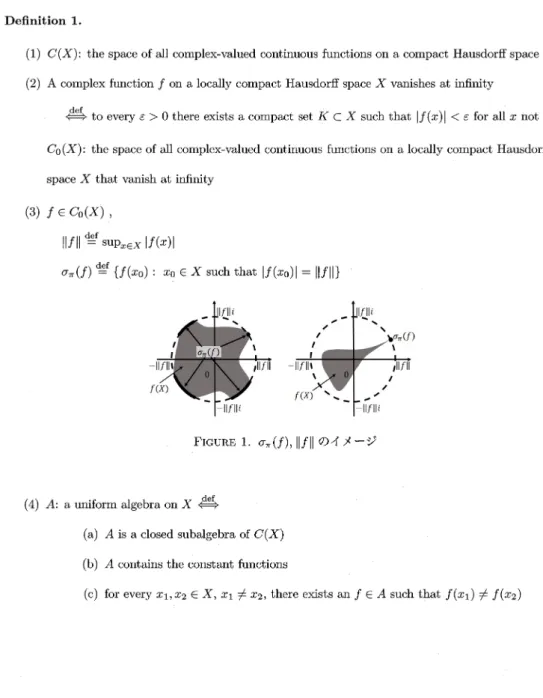
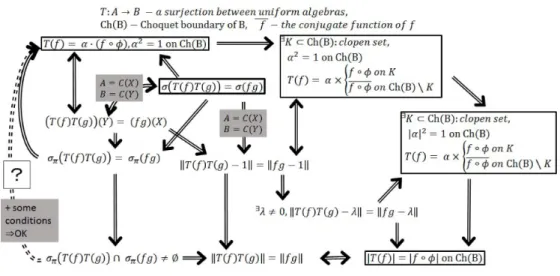
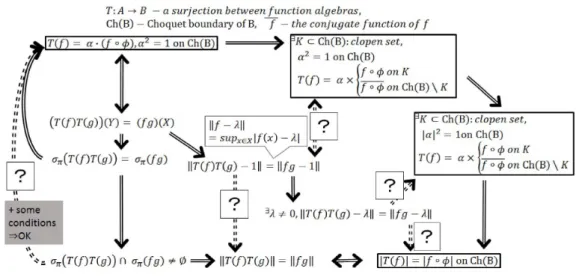
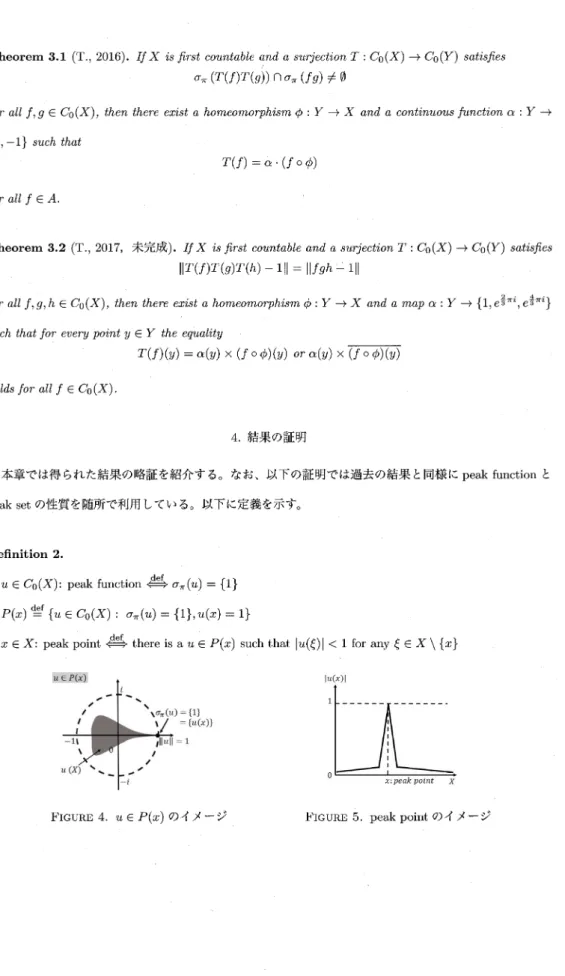
+2
関連したドキュメント
シークエンシング技術の飛躍的な進歩により、全ゲノムシークエンスを決定す る研究が盛んに行われるようになったが、その研究から
Mapping Satoshi KITAYAMA and Hiroshi YAMAKAWA Waseda University,Dept.of Mech.Eng.,59‑314,3‑4‑1,Ohkubo,Shinjuku‑ku Tokyo,169‑8555 Japan This paper presents a method to determine
実際, クラス C の多様体については, ここでは 詳細には述べないが, 代数 reduction をはじめ類似のいくつかの方法を 組み合わせてその構造を組織的に研究することができる
世界的流行である以上、何をもって感染終息と判断するのか、現時点では予測がつかないと思われます。時限的、特例的措置とされても、かなりの長期間にわたり
Instagram 等 Flickr 以外にも多くの画像共有サイトがあるにも 関わらず, Flickr を利用する研究が多いことには, 大きく分けて 2
これを逃れ得る者は一人もいない。受容する以 外にないのだが,われわれは皆一様に葛藤と苦 闘を繰り返す。このことについては,キュプ
緒 梅毒患者の血液に関する研究は非常に多く,血液像
いかなる使用の文脈においても「知る」が同じ意味論的値を持つことを認め、(2)によって
